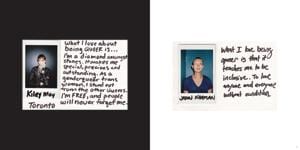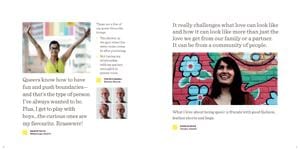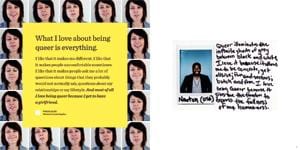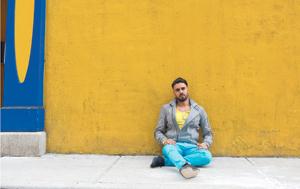
Spreads from What I Love About Being Queer, designed by Karen Campos, with photos by Rodrick Valentine (Edward Ndopu), Drasko Bogdanovic (Ramon Vitug) and Vivek Shraya (Farrah Khan). Credit: Adam coish

Credit: Adam coish

Credit: Adam coish
Vivek Shraya loves being queer. But he didn’t always feel that way. As a writer, musician and filmmaker, Shraya certainly doesn’t shy away from his sexuality in his art. But as an adolescent, he was constantly targeted by bullies who taunted him with homophobic slurs from before he was even entirely sure what they meant.
“For the most part, it was like every day I was harassed,” he says. “And if someone could have given me a button to press that would have turned me into something else, whatever it was, I would have chosen that.” As positive-space coordinator and human-rights advisor at George Brown College and facilitator of Pink Ink, a drop-in writing group for queer youth run by Supporting Our Youth (SOY), a support group for queer youth, he spends a lot of time having conversations with younger members of the community who face many of the same issues he once did.
“One on one, the kinds of conversations that I have with youth are about the same kinds of things that I would struggle with when I was young,” he says. “They end up talking about ‘Is this just a phase? Is this gonna go away?’ So, I really wanted to be able to create something that provided a different perspective. Not to diminish the hardships that queer youth are having, but just to say, ‘Have you thought about the ways that being queer is kinda awesome?’ Because that is not a conversation that I was having when I was a teen.”
It’s certainly a conversation Shraya is committed to engaging with now, as he prepares to release his new book, What I Love About Being Queer. A partnership with George Brown’s Diversity, Equity and Human Rights Services, the book is a beautiful compilation of real responses to the question “What do you love about being queer?” from a diverse cross-section of more than 100 people from around the world. It’s a joyful and exuberant celebration of sexual diversity that serves both as inspiration for queer youth and validation for queer adults. It also represents a significant journey for Shraya and a movement that continues to evolve across a variety of media.
What I Love About Being Queer began as an 18-minute short film of the same name featuring interviews with 34 people. To find subjects, Shraya started by contacting his friends. “I was really curious as to what their answers would be, and that’s what was really fun about the project,” he says. “And what was also fun was people being really stumped, like, ‘Huh, no one’s ever really asked me that before.’” As work on the film progressed, Shraya was struck by the fact that, despite his best efforts, it would be impossible to contain the entire queer spectrum in a short film, which led to phase two of the project. He launched whatiloveaboutbeingqueer.tumblr.com in June 2012, and people from around the world began submitting photos and, of course, things they love about being queer. “That’s the thing about being in Toronto,” he says. “You have a particular social location, and the people that you know end up being the people in the film, the people you’re connected to. So, I created the Tumblr site as a way for anyone to participate in the conversation.”
The conversation continued last year as Shraya took his short on a tour across the country. “At each location I was at, I brought my Polaroid camera and index cards,” he says. “So, after people watched the film, they had the opportunity to have their photo taken and write down a caption about what they love about being queer and join the dialogue. And by the end of the tour, I had over 200 submissions.” Eventually, Shraya found himself with such a wealth of material from the film, the Tumblr and the tour that when a friend asked why he didn’t just turn the whole thing into a book, he quickly took the idea to one of his bosses at George Brown to suggest the partnership.
It’s tempting to draw a connection between What I Love About Being Queer and other youth-targeted queer-positive initiatives like It Gets Better or blog-turned-book-deal Born This Way, but Shraya sees his project as filling a different kind of need. While It Gets Better may promise a brighter future for queer youth, it also implies a bleak present. “And when you’re a kid and you’re getting called ‘fag’ every day — I mean, I felt like I didn’t have a future,” he says. And the Born This Way narrative is something that is directly critiqued in his book. “The thing about Born This Way is that I think it evokes almost a kind of pity. As in ‘Oh, you can’t help it, you’re born that way.’ But I think it’s really radical to say, ‘Actually, I love being queer.’”
Shraya is taking his book and film tour to Victoria, Vancouver, Montreal, Ottawa and London — with a Polaroid in tow, of course. “I’m just excited about watching the project expand and having more and more people engage with it and join the conversation, even if they don’t necessarily agree with the politics.” And with the new material the tour and the still-active Tumblr site are bound to generate, Shraya hasn’t ruled out the possibility of a second volume of What I Love About Being Queer. While the idea that there are too many things to love about being queer to fit into a single book is very satisfying, it’s also very important. “I work really hard to think about the ways the world has gotten better for queer and trans youth,” he says. “But I think as long as we have queer youth killing themselves, the world isn’t changing fast enough.”

 Why you can trust Xtra
Why you can trust Xtra


